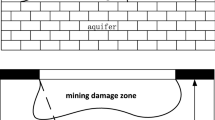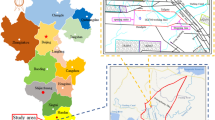Abstract
Due to a gradual increase in mining depths in northern China, the water inrush problem there has become increasingly complex. In the present study, a physical model was developed of a syncline-axis structural fractured zone above confined water, using measured parameters from the Baizhuang coal mine. Using the similarity theory, water inrush from a fractured floor was simulated with different water heads and different structural zones. The mechanism of a delayed water inrush from the floor under the combined action of confined water and a fractured zone was also studied. The results demonstrated that: (1) Water inflow under different pressures; (2) Sand inrush discharges gradually increased under various pressurized water pressures and then decreased; and (3) Based on water and sand inrush discharges, the changes in the Reynolds number and porosity were analyzed, and a “void flow-fissured flow-pipeline flow” transition was proposed. This research provides a basis for developing methods to prevent floor water inrush during deep mining.
Zusammenfassung
Weil sich der Bergbau im nördlichen China zunehmend in größere Tiefen bewegt, wird dort das Problem von Wassereinbrüchen zunehmend komplexer. In dieser Studie entwickelten wir das physikalische Modell einer gestörten Zone in einer synklinalen Achse, welche von gespanntem Wasser unterlagert war. Dafür nutzten wir gemessene Parameter der Baizhuang Kohlenmine. Basierend auf der Ähnlichkeitstheorie, simulierten wir Wassereinbrüche aus gestörtem Liegenden bei unterschiedlichem Wasserdruck und Störungszonen. Auch ein verzögerter Wassereinbruch unter kombinierter Einwirkung von Wasserdruck und Störungszonen wurde untersucht. Die Resultate zeigten, daß (1) Wasserzufluß sich bei unterschiedlichem Druck ereignete, und daß (2) Sandeinbruchraten fortsc hreitend bei verschiedem Druck anstiegen und wieder abnahmen. (3) Mittels der Wasser-und Sandeinbruchraten wurden Reynoldszahl und Porosität analysiert und daraus auf einen Übergang von Hohlraumströmung zur Strömung in einer röhrenartigen Trümmerzone vorgeschlagen. Diese Erkenntnis ermöglicht die Entwicklung von Methoden, um Liegendwassereinbrüchen im tiefen Bergbau vorzubeugen.
Resumen
Debido al aumento gradual de las profundidades en las explotaciones mineras del norte de China, el problema de la irrupción de agua se ha vuelto cada vez más complejo. En el presente estudio, se desarrolló un modelo físico de una zona estructural fracturada de eje sinclínico ubicada arriba de agua confinada, utilizando parámetros medidos de la mina de carbón Baizhuang. Utilizando la teoría de la similitud, se simuló la entrada de agua desde un suelo fracturado bajo diferentes condiciones. También se estudió el mecanismo de una entrada de agua retardada desde el piso bajo la acción combinada de agua confinada y de una zona fracturada. Los resultados demostraron: (1) entrada de agua bajo diferentes presiones; (2) descargas de entrada de arena que aumentaron gradualmente bajo varias presiones de agua a presión y luego disminuyeron, y (3) sobre la base de las descargas de entrada de agua y arena, se analizaron los cambios en el número de Reynolds y la porosidad y se propuso una transición de “flujo en vacío-flujo en fisuras-flujo en cañerías”. Esta investigación proporciona una base para desarrollar métodos para prevenir la irrupción de agua desde el piso en explotaciones mineras profundas.
抽象
由于中国北方煤炭开采深度增加,突水问题更加复杂。建立了一个底板承压的向斜轴构造裂隙带物理模型,用以测量柏庄矿参数。基于相似原理,模拟了不同水头和构造区的底板裂隙突水。同时,研究了水压与裂隙带共同作用下底板滞后突水机理。结果表明:(1) 不同压力下发生涌水;(2) 在各种承压条件下,溃沙逐渐增大,然后减小;(3) 利用水和沙排泄量,分析了雷诺系数和孔隙度变化,提出了“空隙流-压力流-管道流”转换的认识。研究为深部煤炭开采的底板突水防治提供了理论基础。









Similar content being viewed by others
References
Bai H, Ma D, Chen Z (2013) Mechanical behavior of groundwater seepage in karst collapse pillars. Eng Geol 164:101–106
Burger JH, Haldenwang R, Chhabra RP, Alderman NJ (2015) Power law and composite power law friction factor correlations for laminar and turbulent non-Newtonian open channel flow. J Braz Soc Mech Sci 37(2):601–612
Caine JS, Evans JP, Forster CB (1996) Fault zone architecture and permeability structure. Geology 24(11):1025–1028
Chui GX (1990) Similarity theory and model test. China Univ of Mining and Technology Press, Xuzhou
Guo WJ, Zhang SC, Sun WB, Chen JT (2018) Experimental and analysis research on water inrush catastrophe mode from coal seam floor in deep mining. J Chin Coal Soc 43(01):219–227
Hu Y (2017) Mining effect and influencing factors of fault activation water inrush above confined aquifers. PhD diss, AnHui Univ of Science & Technology
Huang K (2012) Exploration of the basic seepage equation in porous media. PhD Diss, China Univ of Geosciences, Wuhan
Huang GS, Zhai XX, Tu XZ, Li RB, Zhang SW (2018) Research on seam floor failure depth in coal mining above aquifer under different conditions. Coal Eng 50(2):95–99
Legrand J (2002) Revisited analysis of pressure drop in flow through crushed rocks. J Hydraul Eng 128(11):1027–1031
Liu P (2017) Experimental and numerical simulating studies on hydrofracturing mechanism of glutenite. PhD diss. China Univ of Mining & Technology, Beijing
Liu QM, Li WP, Zeng XG, Jiang GL, Zhao LT (2007) Indoor hydraulic pressure cracking method to test and measure critical breaking pressure and water resistance coefficient of rock mass. Coal Sci Technol 35(1):85–87
Ma ZG, Miao XX, Chen ZQ, Li YS (2009) Experimental study of permeability of broken coal. Rock Soil Mech 30(4):985–988
Ma D, Rezania M, Yu HS, Bai HB (2016) Variations of hydraulic properties of granular sandstones during water inrush: effect of small particle migration. Eng Geol 217:61–70
Milan V, Andjelko S (1992) Determination of hydraulic conductivity of porous media from grain-size composition (No. 551.49 V 986)
Nanjing Hydraulic Research Institute (2008) Standard for engineering classification of soil. China Planning Press, Xuzhou
Niebling MJ, Toussaint R, Flekkøy EG, Måløy KJ (2012) Dynamic aerofracture of dense granular packings. Phys Rev E 86(6):061315
Pradip KGN, Venkataraman P (1995) Non-Darcy converging flow through coarse granular media. J Inst Eng Civil Eng 504(76):6–11
Qiao W, Li WP (2011) Effect of geo-stress on permeability of groundwater in karst-fractured rock mass. J China Univ Min Tech 40(1):73–79
Ren YH, Shan BJ (2014) Safety Evaluation and numerical simulation of 16# coal seam mining above confined water in Pinggou Coal Mine. Coal Technol (12): 188–191
Shi LQ (2009) Summary of research on mechanism of water-inrush from seam floor. J Shandong U Sci Tech 28(3):17–23
Wang LZ (2014) Accelerated Experimental Study on Permeability for Broken Mudstone with Mass. PhD diss. China U Min Tech, Xuzhou
Wu Q, Liu JT, Zhong YP, Yin ZR, Li JM, Hong YQ, Ye GJ, Tong YD, Dong DL (2002) The numeric simulations of water-bursting time-effect for faults in Zhaogezhuang coal mine, Kailuan, China. J Chin Coal Soc 27(5):511–516
Wu Q, Zhou YJ, Liu JT, Zhong YP, Yin ZR, Li JM, Hong YQ, Zhou RG (2003) The mechanical experiment study on lag mechanism of water-bursting of fault under coal seam. J Chin Coal Soc 28(6):561–565
Wu JW, Tong HS, Tong SJ, Tang DQ (2007a) Study on similar material for simulation of mining effect of rock mass at fault zone. Chin J Rock Mech Eng (S2):4170–4175
Wu FF, Cao P, Wan LH (2007b) Similarity theory and its application in simulation test. Min Technol 7(4):64–65
Zhang SC, Guo WJ, Sun WB, Li YY, Wang HL (2015) Experimental research on extended activation and water inrush of concealed structure in deep mining. Rock Soil Mech 36(11):3111–3120
Acknowledgements
This work was supported by the National Basic Research Program of China (973 Program) under Grant 2015CB251601, and the State Key Program of the National Natural Science Foundation of China under Grant 41430643.
Author information
Authors and Affiliations
Corresponding author
Electronic supplementary material
Below is the link to the electronic supplementary material.
Rights and permissions
About this article
Cite this article
Hu, Y., Li, W., Wang, Q. et al. Evolution of Floor Water Inrush from a Structural Fractured Zone with Confined Water. Mine Water Environ 38, 252–260 (2019). https://doi.org/10.1007/s10230-019-00599-0
Received:
Accepted:
Published:
Issue Date:
DOI: https://doi.org/10.1007/s10230-019-00599-0




